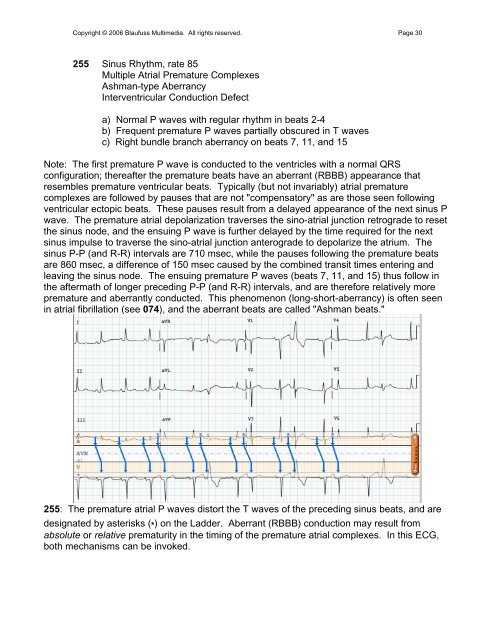002 Sinus Rhythm, atrial rate 90 Mobitz II - Blaufuss Multimedia
002 Sinus Rhythm, atrial rate 90 Mobitz II - Blaufuss Multimedia
002 Sinus Rhythm, atrial rate 90 Mobitz II - Blaufuss Multimedia
You also want an ePaper? Increase the reach of your titles
YUMPU automatically turns print PDFs into web optimized ePapers that Google loves.
Copyright © 2006 <strong>Blaufuss</strong> <strong>Multimedia</strong>. All rights reserved. Page 30<br />
255 <strong>Sinus</strong> <strong>Rhythm</strong>, <strong>rate</strong> 85<br />
Multiple Atrial Premature Complexes<br />
Ashman-type Aberrancy<br />
Interventricular Conduction Defect<br />
a) Normal P waves with regular rhythm in beats 2-4<br />
b) Frequent premature P waves partially obscured in T waves<br />
c) Right bundle branch aberrancy on beats 7, 11, and 15<br />
Note: The first premature P wave is conducted to the ventricles with a normal QRS<br />
configuration; thereafter the premature beats have an aberrant (RBBB) appearance that<br />
resembles premature ventricular beats. Typically (but not invariably) <strong>atrial</strong> premature<br />
complexes are followed by pauses that are not "compensatory" as are those seen following<br />
ventricular ectopic beats. These pauses result from a delayed appearance of the next sinus P<br />
wave. The premature <strong>atrial</strong> depolarization traverses the sino-<strong>atrial</strong> junction retrograde to reset<br />
the sinus node, and the ensuing P wave is further delayed by the time required for the next<br />
sinus impulse to traverse the sino-<strong>atrial</strong> junction anterograde to depolarize the atrium. The<br />
sinus P-P (and R-R) intervals are 710 msec, while the pauses following the premature beats<br />
are 860 msec, a difference of 150 msec caused by the combined transit times entering and<br />
leaving the sinus node. The ensuing premature P waves (beats 7, 11, and 15) thus follow in<br />
the aftermath of longer preceding P-P (and R-R) intervals, and are therefore relatively more<br />
premature and aberrantly conducted. This phenomenon (long-short-aberrancy) is often seen<br />
in <strong>atrial</strong> fibrillation (see 074), and the aberrant beats are called "Ashman beats."<br />
255: The premature <strong>atrial</strong> P waves distort the T waves of the preceding sinus beats, and are<br />
designated by asterisks (*) on the Ladder. Aberrant (RBBB) conduction may result from<br />
absolute or relative prematurity in the timing of the premature <strong>atrial</strong> complexes. In this ECG,<br />
both mechanisms can be invoked.


